What's new in the field artillery
The 155-mm shells are fired by the Charlie 4 battalion during combat training at Fort Irvine National Training Center
Field artillery was transformed from limited-range weapons, requiring a large amount of training, to a high-precision weapons system, combined into a network with a high level of interaction, capable of firing targets at long ranges in an extremely limited time. New technologies contribute to the development of all elements and forms of field artillery, as well as the improvement of other military means.
Until recently, high-precision guidance for projectiles fired from cannons was unattainable for artillery systems in many countries, since extreme overloads experience everything that flies out of the barrel (typical 10000 g or more accelerations), and this requires very expensive hardening of advanced electronics and mechanical devices. Fortunately, modern technologies now make it possible to pack microelectronic circuits with even greater computational power into tiny pieces of silicone with minimum laboriousness. In addition, the emergence of microelectromechanical systems MEMS (Micro-Electro-Mechanical System), which use microprocessor technology for the production of tiny inertial sensors, has radically changed the situation in favor of guided munitions.
The situation with missiles is also not much different. However, due to the significantly milder conditions for their launch, it is not normal that unguided rockets were not completely replaced by their controllable options. But this, in the end, can happen, as more and more manufacturers from different countries offer more and more similar weapon systems on the market.
Although individual guided projectiles remain more expensive than their unmanaged counterparts, they will require significantly less to achieve the desired impact on the target. All other things being equal, more accurate weapons, fired in smaller quantities, also creates a lower risk of indirect losses, while a smaller amount of logistics makes such systems easier to deploy and reduces the size and number of supply columns that are also potentially targeted by the enemy attacks.
Sensor Division
By type of guidance systems are divided into those systems that allow the projectile to fly to a certain point on Earth, and those systems that provide guidance on the energy reflected or emitted by its target. Systems of the first type use satellite or inertial navigation (or both) or trajectory correction commands, while systems of the second type depend on sensors that can see the target directly. The first type is usually cheaper than the second. Of course, it is possible to use systems in any combination, it all depends on the tasks to be performed, the weight and size and power consumption restrictions and the customer’s wallet.
For guidance systems that rely on GPS, inertial navigation system (INS), or trajectory correction commands, accurate target position data obtained by calculating the TCM (Target Coordinate Mensuration) target position coordinates is more important nowadays, because high-precision ammunition shot by inaccurate data will fall past the target very accurately. (Calculation is the process of measuring an element of a terrain or place on earth in order to determine absolute latitude, longitude, and height).
Launched systems, falling into this category include “true” high-precision 155-mm projectiles, for example EXCALIBUR from Raytheon / BAE Systems Bofors, VULCANO from OTO Melara / Diehl Defense and MS-SGP (Multi Service-Standard Guided Projectile) from BAE Systems, although they should also receive the optional semi-active laser guidance system SAL (Semi-Active Laser), which partly changes the situation. Orbital ATK, Precision Guidance Kit (PGK) fuses with trajectory correction, BAE Systems SILVER BULLET, Israel Aerospace Industries (IAI) Top Gun, and possibly the recently introduced AcuFuze from Denel Dynamics, also require a very accurate TCM method. Unguided rockets and guided missiles with the same stringent requirements for TCM include such systems as, for example, the new two-stage A300 rocket with 300 km range from the Chinese company CASC, the LORA rocket from the Israeli IAI, the ACCULAR system and EXTRA from the Israel Military Industries (IMI) and M30 GMLRS (Guided-MLRS) and Lockheed Martin ATACMS guided missiles.
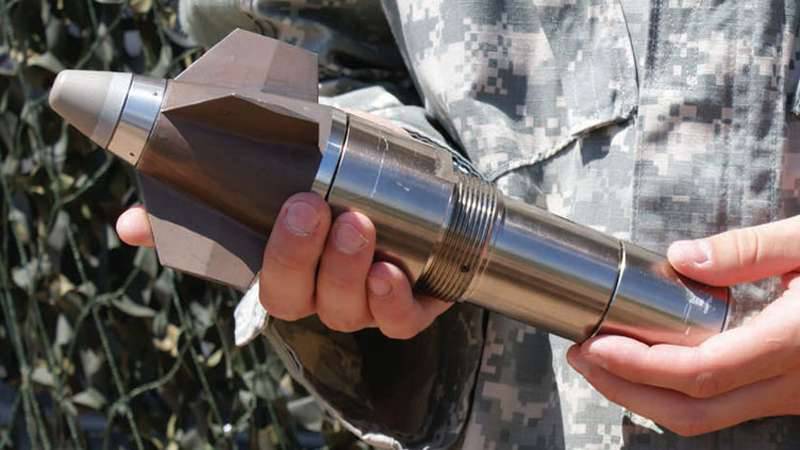
Orbital ATK Precision Guidance Kit (PGK) Precision Guidance Kit
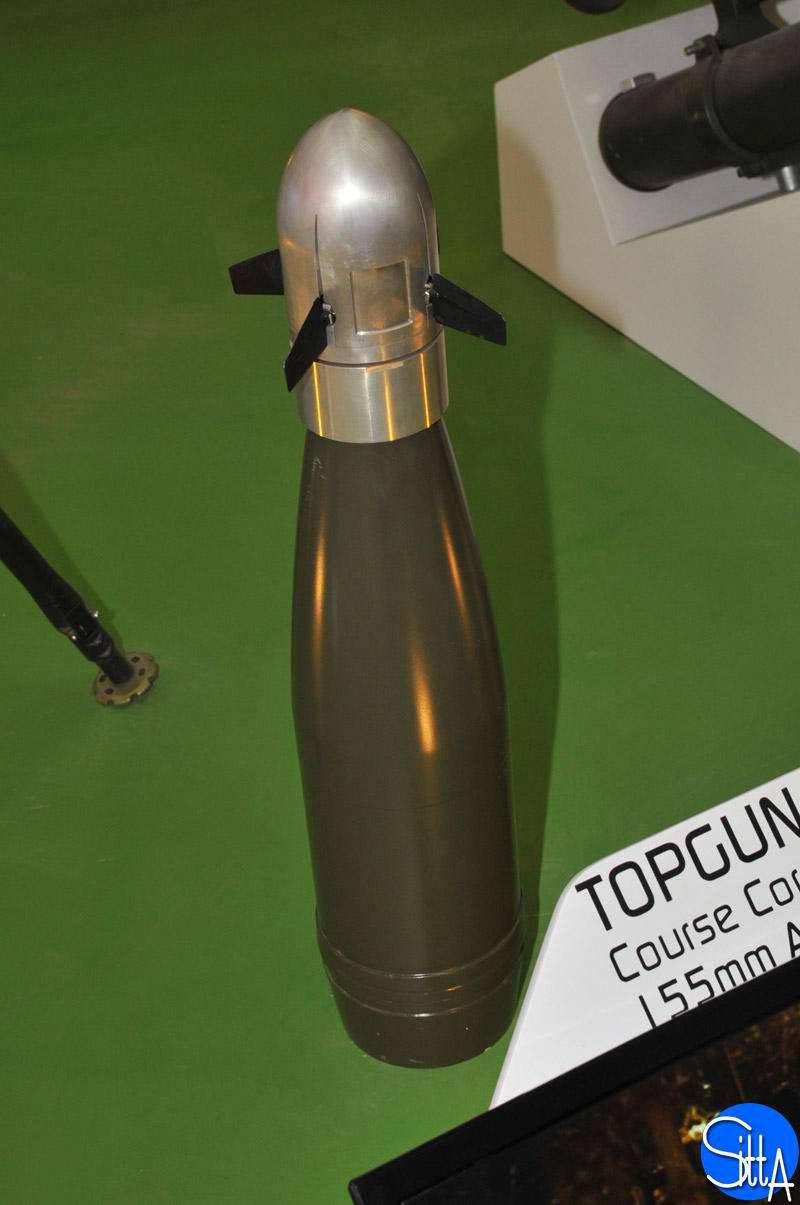
TopGun precision guidance kit from Israel Aerospace Industries
Problem of determining the coordinates of the targets solved?
Probably, the exact location of the firing unit (platform) is less important, since GPS / INS-controlled ammunition can correct errors associated with this. However, for the simplest systems, such as the SPACIDO fuse with Nexter / Junghans projectile course correction and the IMI missile Trajectory Correction System (TCS) system, accurate positioning of the firing unit remains important because these devices do not have their own means of determining their own coordinates. Fortunately, this can for the most part be considered a solved problem due to location and orientation systems integrated into the launch platforms themselves.
Homing heads with laser semi-active homing (SAL) and infrared (IR) guidance can compensate for measurement errors of the target and the gun. However, the less applied the correction of the projectile guidance system, the better. This is primarily true for fuze shells with trajectory correction, since their small aerodynamic control surfaces cannot create as large forces as those available for true precision-guided munitions.
The FM 3-09 field regulations published by the American Army about two years ago, describing the work of field artillery and fire support, contain updated information about their famous five accuracy requirements, which reflect the development of new technologies in this field.
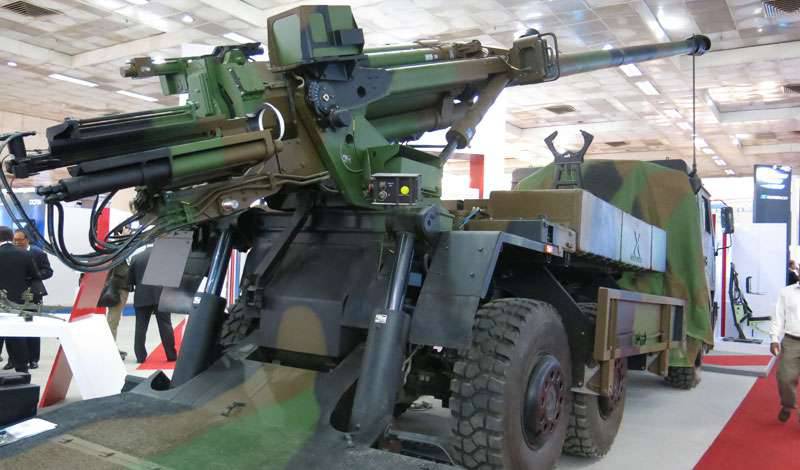
At Eurosatory 2014 exhibition company Nexter has introduced a full set of proven in combat artillery systems: 155-mm self-propelled howitzer CAESAR 6x6, 155-mm towed howitzer TRAJAN and easy 105-mm gun LG1 and finally howitzer CAESAR has, mounted on a truck chassis Ashok Leyland
"Five requirements"
"Since the First World War, our Five Requirements for Accurate Firing on Calculated Data" served us well, but in the modern era of joint operations, GPS, digital systems and precision-guided munitions, it is time to reconsider these five requirements, "writes General William Turner, artillery commander schools in Fort Silla and commander of field artillery. - In particular, the term “by calculated data” in the original name is considered to be not entirely accurate. If we take into account computer automation, devices for determining the position of targets, the use of high-precision and almost accurate ammunition ... we no longer “count in advance”, but rather aim accurately and accurately deliver our fire to the target. Therefore, we changed the name to "Five requirements for high-precision fire."
The requirements themselves remain the same: accurate determination of the location and size of the target, determination of the location of the firing platform itself, information on weapons and ammunition, meteorological data and calculation methods. However, the accuracy that became available as a result of the emergence of new technologies forced the army to prepare artillery calculations to the newly adopted standard of guidance 80: 10: 10, which General Turner describes as a ratio based on an assumption that provides for obtaining “exact coordinates” in 80% of cases . The proportion of 10: 10 refers to the calculation of “almost exact coordinates” with an error in determining the coordinates of the target 50 meters in 10 percent of the cases, and the uncounted, inaccurate coordinates with the error 200 meters make up the remaining 10 percent.
“This relationship is of monumental importance on how to equip and prepare our artillery units,” he writes on. “The key point is that no matter what we shoot - from conventional to high-precision ammunition - we should always try to get the most accurate coordinates under the given conditions and given equipment limitations, before sending a projectile of any type to the target” .
Accurate meteorological information is important in any situation, since wind, air temperature, air density along the projectile or missile trajectory directly affect accuracy. In the American army, it is said that tests in Southeast Asia have shown that shooting uncontrollable projectiles at maximum ranges in extreme heat and at low air density requires correction within 4700 meters. Guided munitions, whose guidance systems rely on the reflected laser beam, are most affected by weather and environmental conditions, for example, their ability to capture targets drops sharply in clouds, fog, sand slurry, smoke, etc. However, these factors do not affect the GPS / INS guidance systems.
As a result of the fruitful cooperation of the two companies, OTO Melara and Diehl Defense demonstrated the outstanding performance of precision-guided munitions of their new VULCANO family during combat shooting.
Tiny QUO
The accuracy that these systems can provide is impressive. The Raytheon company notes that in combat conditions about 770 EXCALIBUR shells were shot, they successively flew within a radius of 2 meters from a precisely localized target, which is equivalent to a circular probable deviation (CVO) of less than one meter. There have also been cases of the use of projectile in 75 meters from their support forces! (The KVO statistic is defined as the radius of the circle into which half the shells will fly)
“We don’t even talk about the QUO anymore,” said Paul Daniels, EXCALIBUR head of Raytheon. - As a rule, GPS signals have an accuracy of up to a meter and this is exactly the accuracy that we deliver to this point; we reach an average of less than two meters, which is a QUO of just over one meter. ”
However, not all armies of the world can form data on targets that would allow to achieve such accurate results, and therefore there is considerable interest in the EXCALIBUR, VULCANO and MS-SGP projectile variants with a laser semi-active homing head. In addition to reducing the requirements for accuracy of data on the purpose of the GOS with guidance on the final part of the trajectory, it is also possible to capture targets that have moved since the last data update, or simply moving continuously.
However, laser designators working with laser homing systems are increasingly becoming part of systems capable of generating data on targets of required quality and these systems are being integrated into a growing array of platforms, ranging from hand-held and tripod devices to UAVs, helicopters, reconnaissance aircraft, ground-based radars, cars advanced artillery surveillance, satellites, etc. From a technological point of view, obtaining sufficiently accurate coordinates for high-precision weapons, apparently, can "make a couple" the problem of determining the location of fire means.
RUAG's COBRA mortar complex includes a ballistic computer (also from RUAG), an automatic barrel targeting system and MRSI mode (multi-round single impact - simultaneous strikes of several projectiles; the barrel angle changes and all projectiles fired at a certain time interval arrive at the target simultaneously ). The complex is designed to fire any standard 120-mm ammunition, including the latest generation of intelligent
Switzerland did not stand aside
At IDEX 2015, RUAG Defense presented the latest COBRA 120 mm mortar set with a semi-automatic loading mechanism, which is a modular system configured to meet individual customer requirements.
The loading mechanism ensures fast and safe loading in any situation, around the clock and in almost any extreme weather conditions.
The RUAG COBRA mortar complex has electronically controlled drives, which allow to increase the possibility of short-term fire with a change of position with high reliability and maximum accuracy throughout its effective range of 9 km.
Thanks to its innovative and compact design, COBRA can be easily mounted on any light tracked or wheeled platform. The COBRA mortar system is available with a full suite of training and logistics solutions based on RUAG's comprehensive artillery approach. According to some sources, Switzerland will buy 1900 DURO machines, 500 model 90 rifles, six drones HERMES 900, 879 light vehicles, as well as RUAG COBRA mortar systems, at least more than a dozen. By 2020, the Swiss defense budget will be replenished with unspent funds that will appear as a result of the refusal to buy GRIPEN aircraft. In addition, the country will spend 560 million Swiss francs to upgrade its F-18 fighter jets.
Shells after rockets
Along with accuracy, the development of artillery should also move in the direction of increasing the range; This is especially true for guns, since they have very limited time and volume, in which the kinetic energy of the projectile needs to be communicated. In the American army, the gun system is considered to be sufficiently effective if it is able to fight targets at distances over 30 km. At the same time, such technologies as increasing the range, such as bottom gas generators and rocket boosters, currently provide a significant increase.
Raytheon Paultheon of this topic said that EXCALIBUR can reach a range of more than 40 km from American 39 caliber guns, while OTO Melara noted that the latest tests of VULCANO in South Africa showed a range of more than 70 km and CWE one meter. In these two systems, different approaches to increasing the range are implemented; in the first case, a bottom gas generator is used, in the second case, a sabot projectile with the best aerodynamic characteristics. The target range for the VULCANO 155-mm projectile is 100 km, while maintaining the meter QUO.
Merging unguided and guided missiles?
At such ranges, the guns begin to block the capabilities of unguided rockets. For example, an ACCULAR “ground-to-ground” tactical guided missile with GPS / INS guidance, based on the LAR-160 unguided missile. This projectile has a range of 14-40 km, diameter 160 mm, length 3995 mm and CWE 10 meters.
According to the US Army, Lockheed Martin’s Guided Multiple Launch Rocket System (GMLRS) guided missile systems, such as the M30, M31 and M31A1, are effective against personnel, lightly armored vehicles and light buildings at distances over 70 km.
The extended range missile EXTRA (Extended Range Artillery Rocket) caliber 306 mm and warhead 120 kg developed by IMI uses GPS / INS guidance in order to reach the 10 KVO at 20-150 km. The trajectory correction system of this company, TCS (Trajectory Correction System), designed for rockets, tracks “more than a dozen” projectiles from the ground and transmits trajectory correction data to the guidance and control system through the data channel, providing the claimed CWO less than 40 meters at all ranges. The TCS system is a cheaper, but less accurate alternative to GPS / INS targeting, but the advantage is that it can be used with all IMI missiles.
Accurate guidance systems provide field commanders with direct and indirect fire capabilities, allowing them to successfully hit targets while reducing indirect losses. In addition, higher accuracy reduces the number of projectiles needed and, accordingly, the volume of logistics
Brazilian guided missiles
There are also companies in South America that develop guided missiles. For example, the Brazilian company Avibras is upgrading its multiple launch rocket system to ASTROS 2020. It will be capable of firing an SS-40G projectile, a controlled version of its 180-mm short-range missile, as well as a AV-TM300 cruise missile with a declared design range of 300 kilometers.
Avibras is working on what it describes as an “autonomous flight control system for positioning, navigating, controlling, and targeting medium-sized rockets”, a project launched by the Brazilian national agency for financing FINEP projects. This research program, designated SPNGC, which develops and manufactures a system with a ground communications component (which includes primarily a communication channel with a missile), for which the ASTROS II SS-40 rocket is used as the base platform.
"The most important advantages ...," they say in the company, "are in reducing indirect losses, the possibility of effective direct fire and reducing the number of installations and missiles needed ... The guidance system is expected to reduce by a quarter the number of missiles needed to achieve the same impact on the target.
“In addition to developing a guided missile and a new tactical missile for the ASTROS 2020, the challenges facing the artillery of the Brazilian army include adopting the new self-propelled artillery mounts M109A5 + BR Bn (2) to improve digital fire support and coordination for field artillery also modernization of ammunition, ”said one of the artillery officers of the Brazilian army.
According to Russian media reports, Russia, in turn, has upgraded its MLRS Tornado-S through the installation of the GLONASS satellite system and the development of guided missiles capable of flying 120 km.
The Chinese corporation Aerospace Science and Technology Corporation (CASC) offers a two-stage rocket projectile with GPS / INS guidance on the final segment of the trajectory. According to reports, the A300 projectile with a warhead weighing 150 kg has an 300 km range and a KNO 30-45 meter. According to the company, four A300 missiles and one DF12 / M20 tactical missile can be launched from one transport-loading launcher.
Sharing launchers for launching free-flying missiles and tactical guided missiles is a well-established practice - a fact that can be easily confirmed by the operators of MLRS and GMLRS MLRS M270 from Lockheed Martin and the ATACMS tactical complex. These missiles are effective against targets such as enemy command posts, command and control centers, supply bases, artillery, rocket and anti-aircraft systems located at distances from 25 to 300 km.
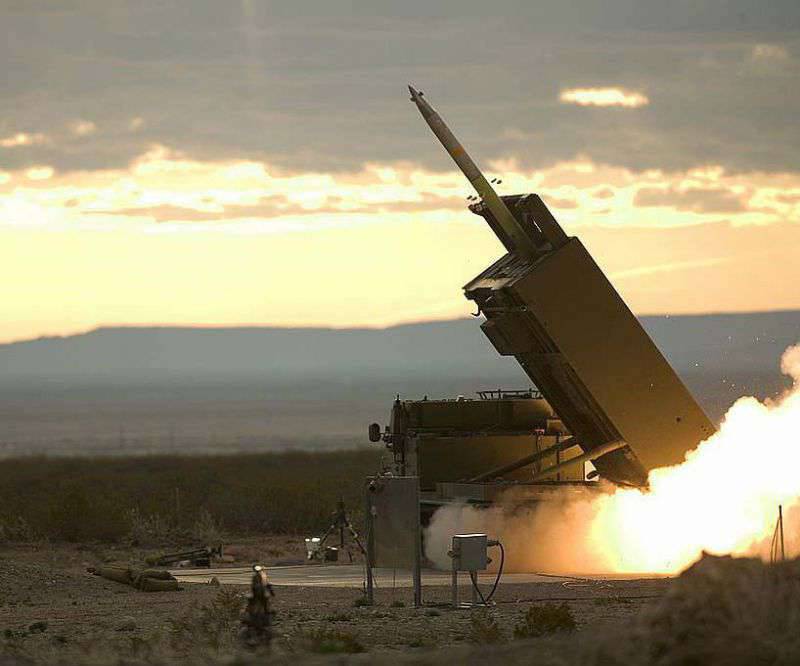
Rocket launch GMLRS complex M270
Top rocket complex ATACMS, below rocket GMLRS
The ATACMS tactical missile system of the ground forces is the only high-precision missile of the American army "long-range ground-to-ground". It is currently undergoing modernization, which is closely related to the modernization of the GMLRS guided missiles. They will replace DPICM (Dual Purpose Improved Conventional Munition - Cluster Combat Units) with alternative Alternative Warhead (AW) warheads, since DPICM cassettes do not comply with international agreements coming into effect in 2019 year, according to the ratio of unexploded ordnance. to burst.
When will the planning bomb replace the missile?
The advent of low-cost high-precision guidance and trajectory correction systems for unguided missiles blurs the differences between them and guided missiles. In another project that brings these systems closer together, Boeing and Saab teamed up to create a ground-to-ground GLSDB (Ground Launched Small Diameter Bomb) small-diameter guided munition that will give the artillery troops flexible and highly maneuverable high-precision impact capabilities. GLSDB is a small-sized controllable fixture aviation Boeing GBU-39V SDB bombs, with satellite guidance system (GPS), as the head of the 227 mm M26 unguided rocket used in the M270 MLRS MLRS. The first test launches, in which the M26 solid propellant rocket engine from an MLRS uncontrolled rocket, pushed the SDB out of the launch tube and accelerated to the calculated flight speed before separating, were carried out in February 2015 in accordance with the agreement signed in August 2014.
“Boeing and Saab have proven they can launch safely, we can split the steps and the SDB ammunition will work just as if it were an air launch bomb,” said Boeing’s GLSDB project manager Chris Lassky. - We were able to launch launches against air targets, bunkers and caves; we can run the Small Diameter Bomb, in fact, in any direction 360 degrees over a distance of 150 km with an accuracy of one meter. ”
The GLSDB high-precision, small-diameter guided munition is the only weapon that combines a similar range with the ability to launch up to six ammunition at a time. He realizes new ground artillery capabilities regarding the destruction of targets at virtually any angle, including the reverse slopes of the mountains.
“The enemy today is trying to gain a foothold on the mountain slopes and the like in order to avoid a ballistic missile attack, which can only strike in one way,” said the GLSDB project manager at Saab Par Yarbus.
GLSDB can attack targets from any angle and is therefore a possible solution to the dead space problem during artillery operations in urban environments. The FM 3-09 charter defines dead space when fired from closed positions as a zone “along the observer-target line, or the gun-target line behind an object, such as a hill or building, when the projectiles are either not visible or cannot hit the target”. A good rule of thumb is that the dead space for ammunition intended for hitting area targets is typically five times the height of buildings when fired at low elevation angles and half the height of buildings when firing at high elevation angles. The GLSDB ammunition, after separating the starting charge, M26 plans, i.e., ammunition locking, such as HAROP from IAI and FIRE SHADOW from MBDA, can provide a more flexible alternative in some situations.
Since artillery must support troops and combat commanders in the field coordinate with air strikes, support for ship guns and other means, interoperability is necessary due to the general sequence of actions and common terminology, reliable network communication and decision support tools that will help gunners understand very difficult situations. This is especially true for allied and coalition operations.
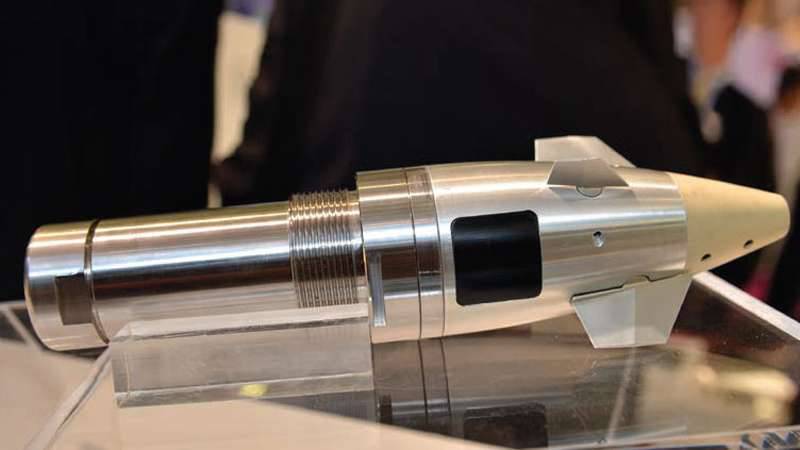
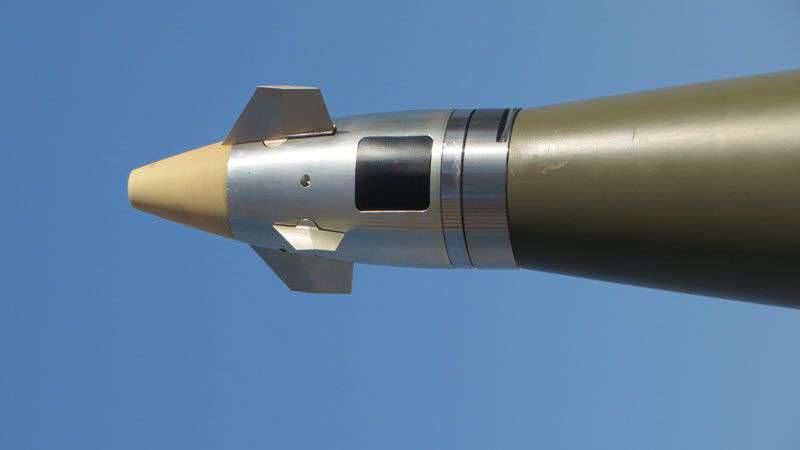
The SILVER BULLET precision guidance kit from BAE Systems turns the standard 155-mm artillery shell into precision-guided ammunition.
Proven technology
When mentioning field artillery, you should not forget about the already proven systems created by companies such as Rheinmetall, Roketsan and ST Kinetics.
As a major supplier of ground-based systems and equipment, Rheinmetall offers an expanded range of extended-range 155-mm ammunition for a wide range of applications. These include high-explosive shells (some with a low-sensitivity explosive), lighting projectiles for the visible and infrared spectra, multispectral smoke / aerosol projectiles, a SMart with a touch fuse and practical ammunition. An autonomous, highly efficient, intelligent shot-and-forget SMArt155 artillery projectile has remarkable economic efficiency. Known in the Bundeswehr under the designation DM702, SMArt 155 can be shot from any 155-mm gun.
The light, effective and reliable rocket of the Turkish company Roketsan TR-107 has one of the largest ranges among analogs and fully meets such demanded characteristics as accuracy and dispersion. The 107-mm missile can be launched from a towed installation, from a self-propelled installation or from a platform with a launch container manufactured by Roketsan. He is currently in service with the Turkish army and the armies of many countries of the world.
Due to the aerodynamic shape and the mixed solid-fuel engine, the TR-107 missile has long ranges up to 11 km, while classic missiles have an 8 km range. The accuracy of this rocket is ensured by the rotation created by the perforations in the nozzle. TR-107, equipped with a high-explosive warhead and having effective firepower, can be successfully used for small targets, as well as area targets in 11 radius of km.
The missile can be launched from both the classic 12-pipe systems, and from the sealed composite launch containers manufactured by Roketsan. When used with such disposable composite containers, the ready-to-launch complete rocket is fully protected from adverse environmental conditions (including weather) at all stages, including storage and processing in the field.
Singapore-based ST Kinetics (STK) offers various charges and warheads for 155-mm artillery ammunition to meet various combat requirements. STK 155 mm ammunition manufactured by STK is also available with low-sensitive warheads developed using special methods of developing inert explosives and special technologies for the production of explosive compositions. The mortar complex SRAMS of 120 mm caliber of ST Kinetics company became one of the first systems in the world, which, when firing a maximum charge at a range of 10 km, have a recoil force of less than 30 tons. With a mass of just 1200 kg, it can be installed on a wide variety of light wheeled and tracked vehicles, thereby providing the lower echelons with great fire power.
YugoImport SDPR company offers a wide range of military vehicles and military equipment, including artillery, MLRS, armored combat vehicles, individual weapons and the latest innovative systems in the field of military equipment and security. The self-propelled wheeled artillery mount NORA-B52 K1 of this company is an upgraded version of the NORA-B52 KE SAU. The updated system is more modern OMS with improved hardware and software, providing better navigation on the battlefield, pointing the trunk in azimuth and elevation and fully automated calculations of data for shooting; repacked and reinforced cabin that meets the requirements for increased ballistic protection; and more advanced truck chassis with better off-road maneuverability. The 155-mm gun barrel has a 52 caliber length, it is equipped with a semi-automatic shutter mechanism and an innovative charging chamber self-sealing system.
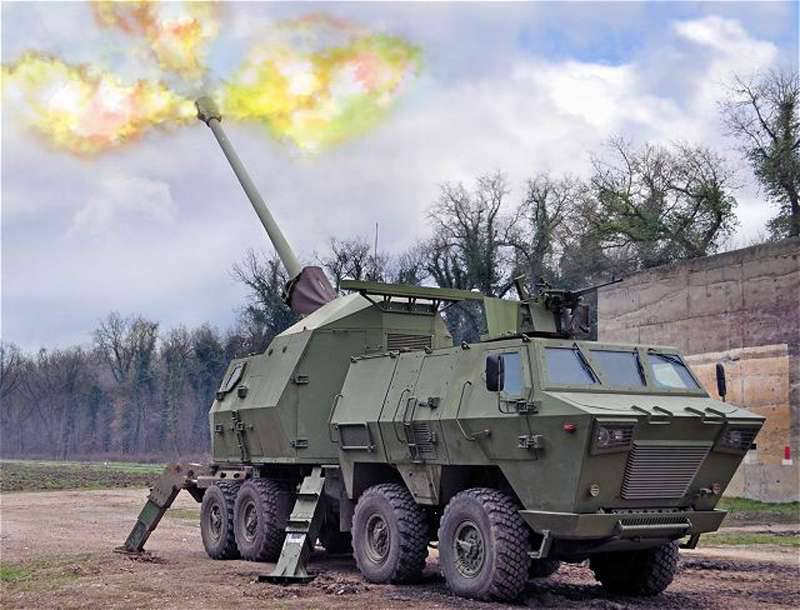
Self-propelled gunnery NORA-B52 K1 Serbian company YugoImport SDPR
Modern artillery ammunition caliber 155 mm, used by self-propelled howitzer PzH 2000
Joint fire support
The main component that focuses on multinational interaction through command and control is the Artillery Systems Cooperation Activities (ASCA) artillery systems joint action system. The ASCA program installed in each fire control system is described as a translator that takes information from the country requesting fire support and converts it into a form that allows another country to provide fire support most effectively.
“At present, the ASCA interface allows real-time collaboration between France, Italy, Turkey, the United States and Germany, and this extends even to combat shooting,” says the report of the Chief of General Staff of the German Army, General Bruno Karsdofa. “The exceptional opportunities for international cooperation are supported by very good results of joint artillery firing during international exercises, such as Combined Endeavor 2013 in Germany, the Bold Quest in the USA in May 2014, and the participation of German troops in Italian combat-shooting exercises.”
In a broader sense, the JFS (Joint Fire Support) joint fire support concept is designed to be used by the best national and multinational weapons systems in the area in order to achieve the desired impact, for which JFS as part of the main units should advise combat commanders and ensure coordination of land and sea forces. indirect guidance systems, as well as air weapons systems.
For example, the ADLER III artillery fire control system developed by ESG will soon enter service with the German army and support these requirements of the JFS concept. The ADLER III system has in its decision support tools that prioritize reports about a goal that it receives based on user-defined criteria, such as the origin and relevance of the report, the target area, its position in the list of priority goals, etc. After deciding to fire a target, the ADLER system proposes a combination of weapon systems for use, based on their availability, range and type of ammunition regarding the desired impact.
The decision to direct resources to advanced compatible fire control systems is an obvious decision, but investing in high-precision long-range ammunition for cannons or precision-guided unguided and guided missiles is less obvious and it will be interesting to watch this process.
Materials used:
www.baesystems.com
www.saabgroup.com
www.ruag.com
www.yugoimport.com
www.imi-israel.com
www.wikipedia.org
en.wikipedia.org
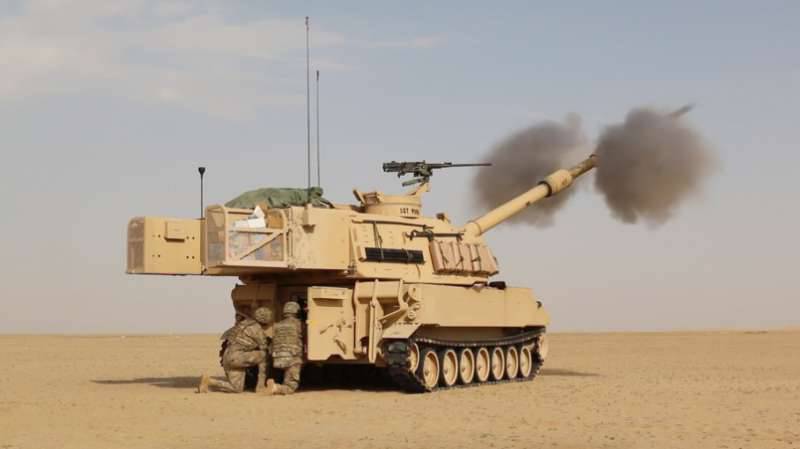

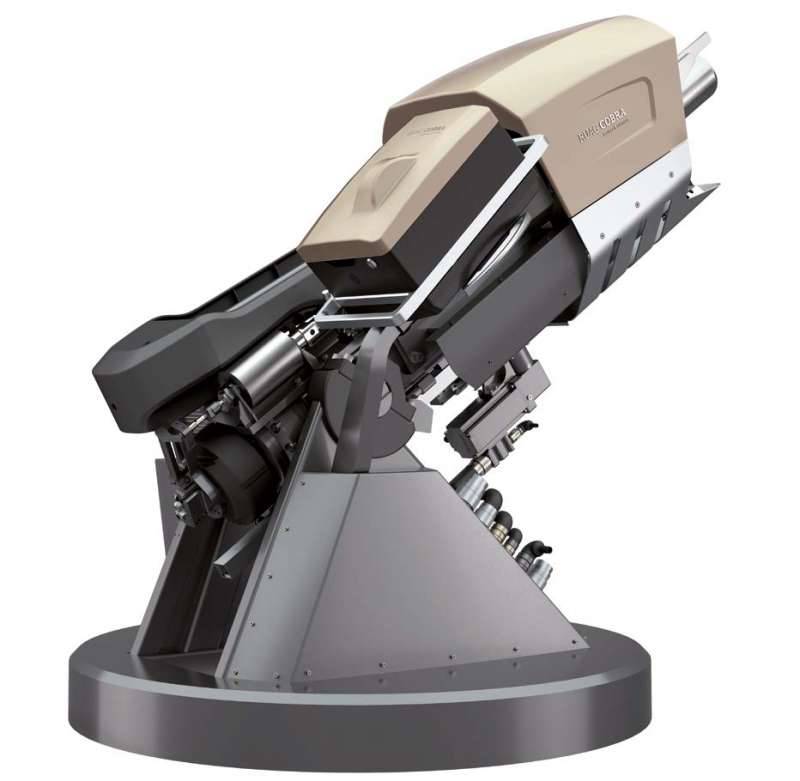
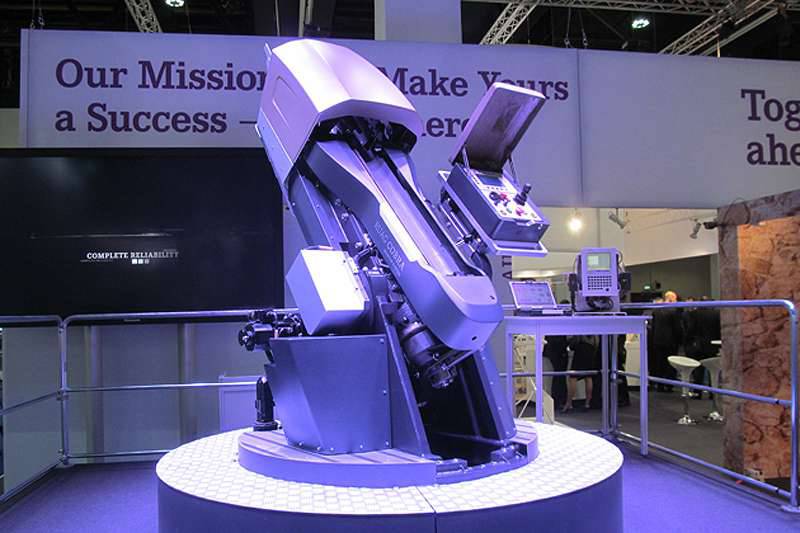
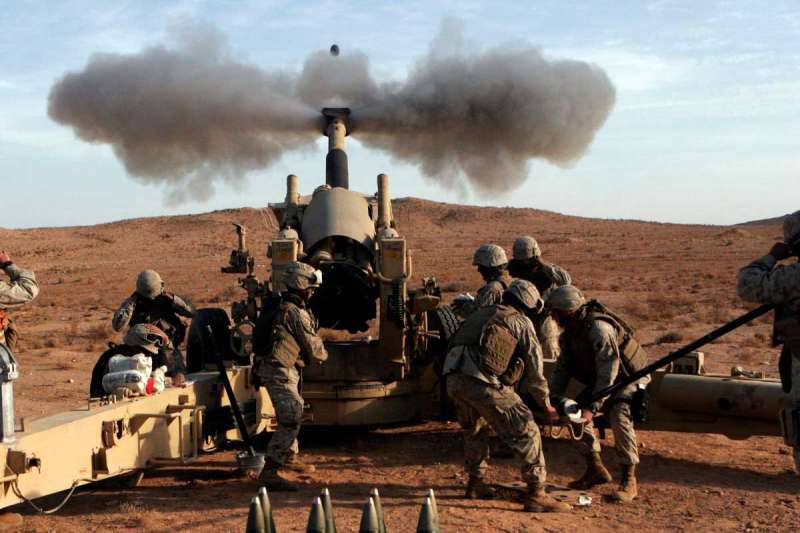
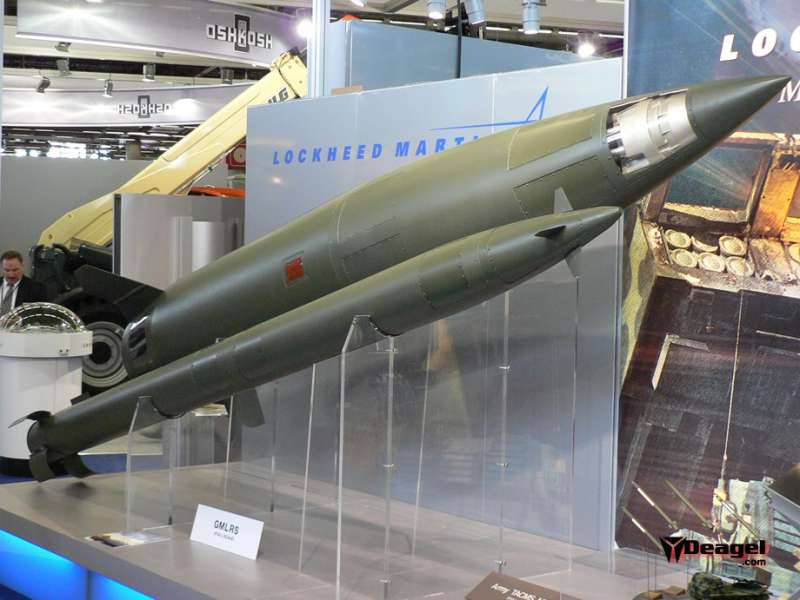
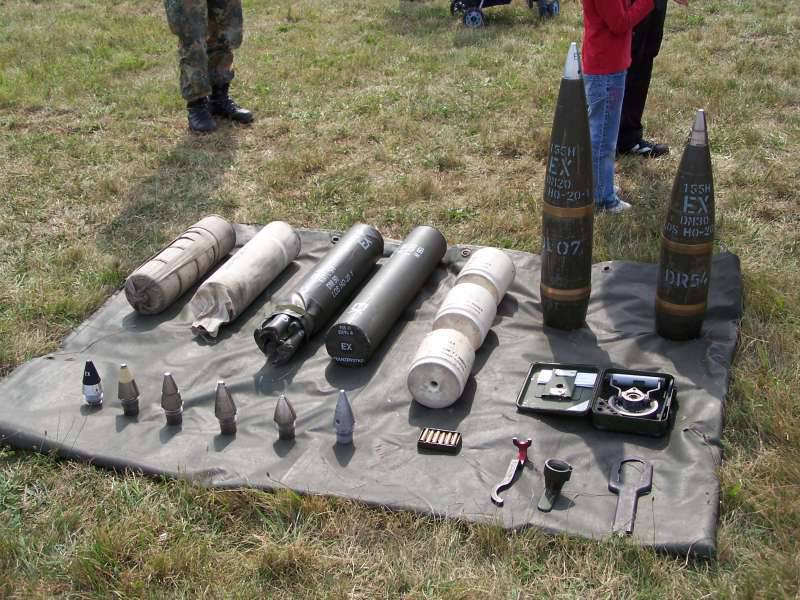
Information